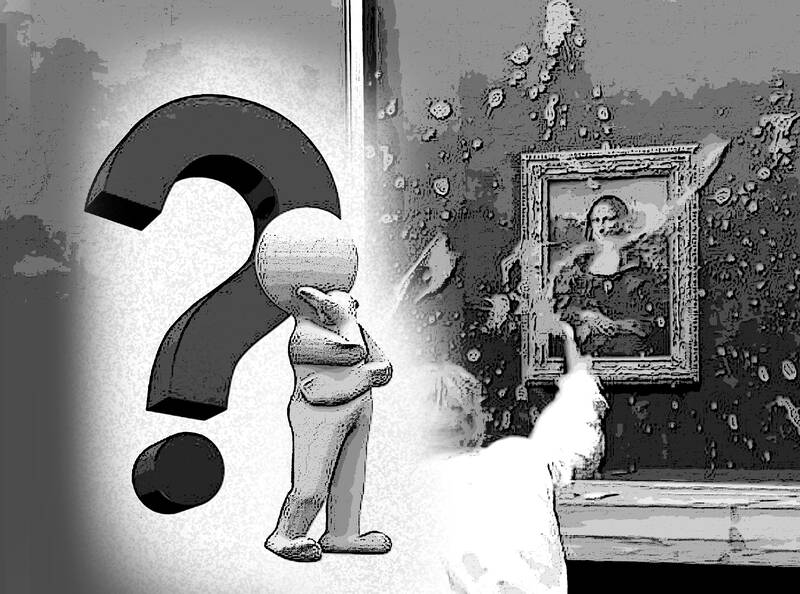Mais non! gasped at least one visitor recorded on video on Sunday morning last week as two women splashed orange liquid — or soup, as several news accounts had put it — at Leonardo da Vinci’s Mona Lisa. Immediately, the splatterers slipped under the semicircular barrier the Louvre has in place to keep onlookers at a distance from the 16th-century masterpiece. Removing their overcoats, the women revealed T-shirts reading “Riposte Alimentaire” or “Food Response,” an organization that is part of a broader alliance of environmental activists. One shouted: “What’s more important? Art or the right to healthy and sustainable food?” They were both arrested.
The painting — in the past, the target of acid, cake, rock and teacup, as well as a 1911 abduction — has been displayed behind a bulletproof glass shield since 2005. It is highly unlikely to have been harmed by the latest assault. The trauma was mostly borne by eyewitnesses and by France itself, which is in the grips of nationwide protests by farmers who began besieging Paris this week. The rest of the world? The ripple effects reach us in an inchoate, perhaps shoulder-shrugging way. No harm, no foul, right?
The Mona Lisa — or La Gioconda, the name many Europeans know it by — has been a touchstone of Western civilization for so long that we often forget why it is important. No one can put a price on it because the Louvre would never sell it. It has been a French possession since King Francis I purchased it in the early 16th century, soon after Da Vinci died in France. We believe it is precious because people keep saying it is precious — like being famous for fame’s sake. Da Vinci’s painting has become an icon in the worst way possible: It is recognizable in its barest outlines, which makes it easily reproducible and marketable, emblazoned on everything from umbrellas to postcards to refrigerator magnets.

Illustration: Constance Chou
The Mona Lisa is, thus, a very convenient goddess to worship, yet also a goddess of what French artist Marcel Duchamp satirized through pop-commercial idolatry in 1919 by drawing a moustache on a postcard image of the painting and giving it a title — LHOOQ — that is titillating when pronounced in French.
The Mona Lisa is everywhere in facsimile. Yet her real power is limited, palpable only when you see her in person, on that wall in the Louvre.
The wonder of Da Vinci’s classic is — as cliched as it sounds — the smile. It is not an accident of the paintbrush: It was consciously engineered from pigment and science via Da Vinci’s mastery of sfumato, that borderless, smoke-and-mirrors melding of planes of color to create the appearance of multiple dimensions. The conceptual basis of it all was his pioneering study of human anatomy through the dissection of the dead. Studying corpses through three decades, he learned that the muscles that control the mouth follow a complex orchestration, not only of the minuscule tissues around our lips, but the surrounding ones in the rest of the head. He identified anger muscles and pain muscles for the expressions they helped to generate.
Summarizing that forensic achievement, Walter Isaacson, the author of a bestselling 2017 Da Vinci biography, as well as and my former boss at Time magazine, wrote: “He sketched head-on and profile drawings of retracted lips with the skin still on, then a row of lips with skin layer peeled off. This is the first known anatomical drawing of the human smile.”
Yet there was more than that to the painting. As Isaacson discussed in a November 2017 article in The Atlantic, anatomical insights had to be turned into art. It started with using lead white pigment (gesso) to prepare a white poplar wood panel for painting, all to maximize the reflection of light. The contouring of the surfaces of Mona Lisa’s face were craftily strategized with irregular strokes to make them appear as if they were skin. His deep knowledge of optics also allowed him to create a smile that changed as you looked at it from different angles, just as a real person’s expression shifts in emotional depth in relation to where you stand.
“The result,” wrote Isaacson, “was a masterpiece that invites and responds to human interactions, making Leonardo [Da Vinci] a pioneer of virtual reality.”
All that is impossible to replicate in a postcard. It is hard enough to experience at the Louvre where the large room dedicated to the Mona Lisa is packed with visitors and catching a full glimpse of the painting is difficult enough, much less seeing it from various perspectives.
However, Da Vinci’s stunning feat — a divinely Delphic smile that is the product of the sweat of human genius — is what was threatened by the assailants on Sunday morning last week in Paris.
Is it art for earth’s sake? Or earth for art’s sake? We could debate those points, but we should not resort to savagery. Would it be worth living in a world that chose to wipe the smile off of the Mona Lisa? The assault on Sunday last week was toothless because of the glass barrier. Yet the semiotics, if not the actions themselves, were violent. Too many other works of art have been desecrated in the name of some greater good. There is much to be outraged about in the world, but we should not turn anger into destruction. That would be like trying to save the planet, but destroying it in the process.
Howard Chua-Eoan is a columnist for Bloomberg Opinion covering culture and business. He previously served as Bloomberg Opinion’s international editor and is a former news director at Time magazine. This column does not necessarily reflect the opinion of the editorial board or Bloomberg LP and its owners.